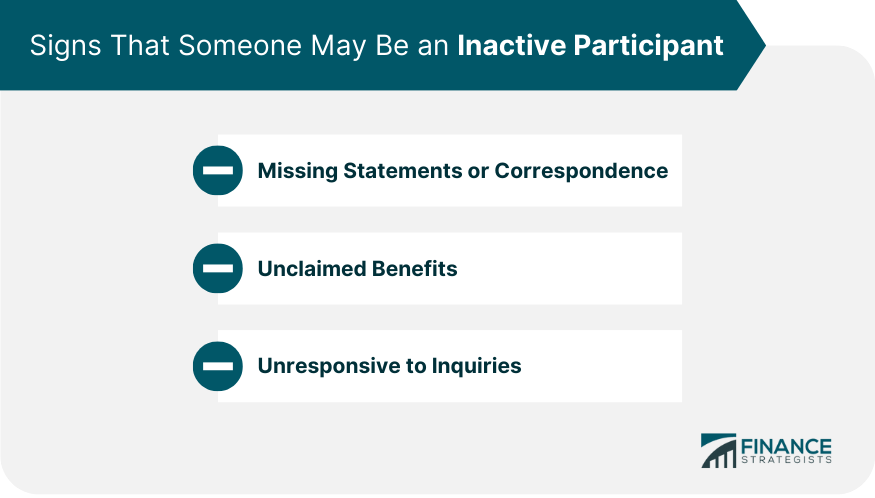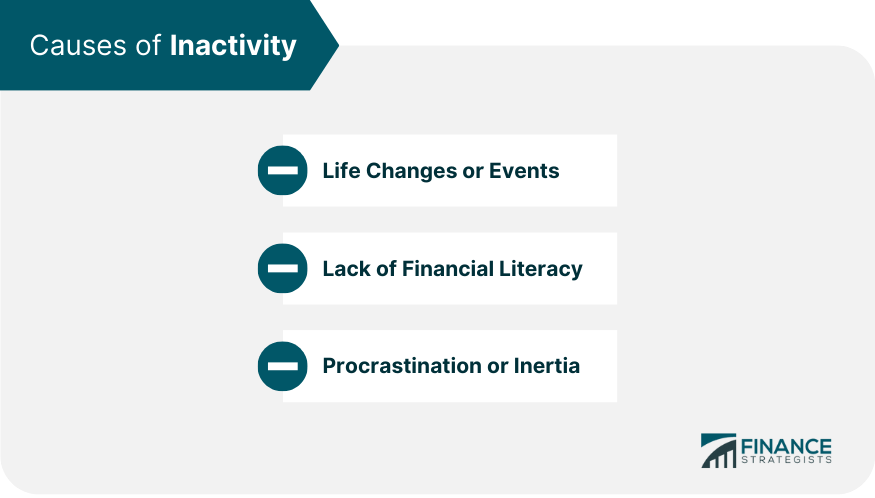An inactive participant is an individual who does not actively manage or contribute to their investment accounts, such as retirement accounts or brokerage accounts. Several factors, including lack of contributions, no account activity, and no contact or communication, can characterize inactivity. Inactive participants may miss out on investment growth opportunities and potentially face financial losses, legal and regulatory challenges, and emotional stress due to their lack of engagement in managing their investments. Identifying and re-engaging inactive participants through targeted outreach efforts can help them become more involved in their financial planning, make informed decisions, and achieve their long-term financial goals. An inactive participant is an individual who does not actively manage or contribute to their investment accounts, such as retirement accounts or brokerage accounts. Several factors, including lack of contributions, no account activity, and no contact or communication, can characterize inactivity. Inactive participants may miss out on investment growth opportunities and potentially face financial losses, legal and regulatory challenges, and emotional stress due to their lack of engagement in managing their investments. Identifying and re-engaging inactive participants through targeted outreach efforts can help them become more involved in their financial planning, make informed decisions, and achieve their long-term financial goals. Inactive participants can be identified by certain signs, such as: Missing Statements or Correspondence: The individual does not receive or open statements, newsletters, or other communications related to their account. Unclaimed Benefits: There are unclaimed benefits or assets in the individual's name that have yet to be accessed or acknowledged. Unresponsive to Inquiries: The individual needs to respond to inquiries or attempts at communication from the financial institution or other stakeholders. Inactive participants may become disengaged due to significant life events, such as: Job Changes: A change in employment may result in a change in retirement account providers or a lapse in contributions. Relocation: Moving to a new location may lead to a disruption in communication with the financial institution. Illness or Disability: Health issues may prevent individuals from actively managing their investments. A limited understanding of financial concepts and investment options can contribute to inactivity: Limited Understanding of Investment Options: Inactive participants may be unsure of how to select and manage investments, leading to inaction. Confusion About Account Management: Individuals may need help accessing, navigating, or changing their accounts. Some individuals may become inactive participants due to procrastination or inertia: Intimidation by the Complexity of the Financial System: Fear of making a mistake or being overwhelmed by financial jargon and concepts may lead to inaction. Fear of Making Wrong Decisions: Inactive participants may be concerned about making the wrong investment choices, leading to a reluctance to engage with their accounts. Inactivity can lead to several negative financial outcomes: Missed Opportunities for Investment Growth: Inactive participants may not benefit from market gains or long-term investment strategies. Potential Loss of Assets: Unclaimed or forgotten assets may be lost over time due to regulation changes or account closures. Higher Fees or Penalties: Inactive accounts may incur additional fees or penalties for non-participation. Inactive participants may also face legal and regulatory challenges: Unclaimed Assets: Governments may seize unclaimed assets, which may be difficult to recover. Potential Non-compliance With Regulations: Inactivity may lead to non-compliance with financial regulations, resulting in penalties or other consequences. Being an inactive participant can also lead to emotional stress and insecurity: Anxiety About Financial Future: Inactive participants may worry about their ability to achieve their financial goals. Regret Over Missed Opportunities: Inactive participants may experience regret over not taking advantage of investment opportunities or maximizing their financial potential. Improving communication and education can help re-engage inactive participants: Use of Multiple Communication Channels: Employ a variety of channels, such as email, phone calls, and mail, to reach out to inactive participants. Simplified Messaging and Content: Create easy-to-understand content that breaks down complex financial concepts and makes account management more approachable. Financial Education Programs: Offer workshops, seminars, or online courses that help individuals build their financial knowledge and confidence. Simplifying account management can encourage inactive participants to become more engaged: Easier Account Access and Navigation: Improve the user experience of account management platforms, making it simpler for individuals to access and navigate their accounts. Consolidation of Accounts: Facilitate the process of combining multiple accounts, making it easier for individuals to manage their investments. Incentives can be used to encourage inactive participants to re-engage with their accounts: Employer-Sponsored Programs: Employers can offer matching contributions, bonuses, or other incentives for employees to actively participate in their investment accounts. Government Initiatives: Governments can create tax incentives or other programs encouraging individuals to manage their investments actively. Financial Institution Promotions: Financial institutions can offer promotions or rewards for individuals who take steps to become more engaged with their accounts. Financial institutions have a responsibility to: Monitor and Identify Inactive Participants: Keep track of account activity and contact inactive participants to offer assistance. Provide Support and Resources: Offer educational materials, customer support, and account management tools to help individuals become more active participants. Employers should: Encourage Employee Participation: Promote the importance of active engagement in investment accounts and provide resources to help employees make informed decisions. Offer Financial Education and Guidance: Provide access to financial education programs and professional advice to help employees navigate their investment options. Government agencies must: Develop Policies and Initiatives to Encourage Re-Engagement: Create programs and incentives promoting active investment account participation. Oversee Regulations and Compliance: Ensure that financial institutions and individuals comply with relevant laws and regulations. Individuals have a responsibility to: Recognize the Importance of Active Participation: Understand the long-term benefits of actively managing their investments and commit to becoming more engaged. Seek Professional Advice and Assistance When Needed: Reach out to financial professionals or utilize educational resources to build their financial knowledge and confidence. Addressing the issue of inactive participants is vital for maximizing individuals' financial potential and securing their long-term financial well-being. It is important to understand the criteria that define an inactive participant and recognize the various causes of inactivity, such as life changes, lack of financial literacy, and procrastination. The consequences of being an inactive participant can lead to financial losses, legal and regulatory challenges, and emotional stress. To combat inactivity, stakeholders should focus on enhancing communication and education, streamlining account management, and incentivizing participation. The responsibilities of financial institutions, employers, government agencies, and individuals are crucial in addressing this issue and encouraging active engagement in investment management. By taking a proactive approach and seeking help when needed, individuals can take control of their financial future and make informed decisions about their investments.What Is an Inactive Participant?
Identifying an Inactive Participant
Criteria for Being an Inactive Participant
Signs That Someone May Be an Inactive Participant
Title: Signs That Someone May Be an Inactive Participant
Causes of Inactivity
Life Changes or Events
Lack of Financial Literacy
Procrastination or Inertia

Consequences of Being an Inactive Participant
Financial Implications
Legal and Regulatory Issues
Emotional Stress and Insecurity
Strategies to Re-Engage Inactive Participants
Enhancing Communication and Education
Streamlining Account Management
Incentivizing Participation
Responsibilities of Various Stakeholders Toward Inactive Participants
Financial Institutions
Employers
Government Agencies
Individuals
Conclusion
Inactive Participant FAQs
An inactive participant is someone who has signed up for a program or service but has yet to engage with it actively.
The consequences of being an inactive participant depend on the program's terms and conditions. Sometimes, you may be removed from the program, lose access to certain features, or be charged a fee.
To avoid becoming inactive participants, regularly engage with the program by completing tasks, attending meetings or events, and staying up-to-date with program communications.
It depends on the program. Some programs may offer benefits to inactive participants, while others may not. Check the program's terms and conditions or contact the program administrator to find out.
Programs can encourage inactive participants to become more engaged by offering incentives or rewards, sending personalized communications, providing additional resources or support, or creating a sense of community among participants.
True Tamplin is a published author, public speaker, CEO of UpDigital, and founder of Finance Strategists.
True is a Certified Educator in Personal Finance (CEPF®), author of The Handy Financial Ratios Guide, a member of the Society for Advancing Business Editing and Writing, contributes to his financial education site, Finance Strategists, and has spoken to various financial communities such as the CFA Institute, as well as university students like his Alma mater, Biola University, where he received a bachelor of science in business and data analytics.
To learn more about True, visit his personal website or view his author profiles on Amazon, Nasdaq and Forbes.











